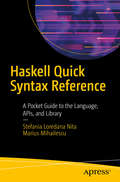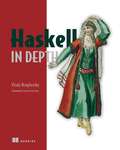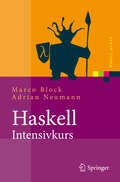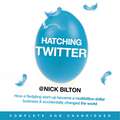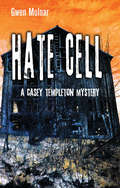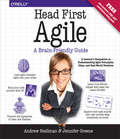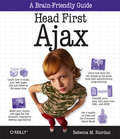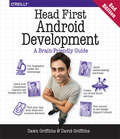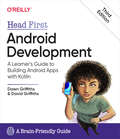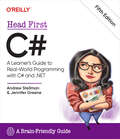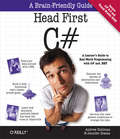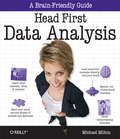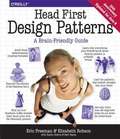- Table View
- List View
Haskell Financial Data Modeling and Predictive Analytics
by Pavel RyzhovThis book is a hands-on guide that teaches readers how to use Haskell's tools and libraries to analyze data from real-world sources in an easy-to-understand manner.This book is great for developers who are new to financial data modeling using Haskell. A basic knowledge of functional programming is not required but will be useful. An interest in high frequency finance is essential.
Haskell High Performance Programming
by Samuli ThomassonBoost the performance of your Haskell applications using optimization, concurrency, and parallel programming About This Book * Explore the benefits of lazy evaluation, compiler features, and tools and libraries designed for high performance * Write fast programs at extremely high levels of abstraction * Work through practical examples that will help you address the challenges of writing efficient code Who This Book Is For To get the most out of this book, you need to have a working knowledge of reading and writing basic Haskell. No knowledge of performance, optimization, or concurrency is required. What You Will Learn * Program idiomatic Haskell that's also surprisingly efficient * Improve performance of your code with data parallelism, inlining, and strictness annotations * Profile your programs to identify space leaks and missed opportunities for optimization * Find out how to choose the most efficient data and control structures * Optimize the Glasgow Haskell Compiler and runtime system for specific programs * See how to smoothly drop to lower abstractions wherever necessary * Execute programming for the GPU with Accelerate * Implement programming to easily scale to the cloud with Cloud Haskell In Detail Haskell, with its power to optimize the code and its high performance, is a natural candidate for high performance programming. It is especially well suited to stacking abstractions high with a relatively low performance cost. This book addresses the challenges of writing efficient code with lazy evaluation and techniques often used to optimize the performance of Haskell programs. We open with an in-depth look at the evaluation of Haskell expressions and discuss optimization and benchmarking. You will learn to use parallelism and we'll explore the concept of streaming. We'll demonstrate the benefits of running multithreaded and concurrent applications. Next we'll guide you through various profiling tools that will help you identify performance issues in your program. We'll end our journey by looking at GPGPU, Cloud and Functional Reactive Programming in Haskell. At the very end there is a catalogue of robust library recommendations with code samples. By the end of the book, you will be able to boost the performance of any app and prepare it to stand up to real-world punishment. Style and approach This easy-to-follow guide teaches new practices and techniques to optimize your code, and then moves towards more advanced ways to effectively write efficient Haskell code. Small and simple practical examples will help you test the concepts yourself, and you will be able to easily adapt them for any application.
Haskell Quick Syntax Reference: A Pocket Guide to the Language, APIs, and Library
by Stefania Loredana Nita Marius MihailescuThis condensed code and syntax reference presents the essential Haskell syntax in a well-organized format that can be used as a quick and handy reference, including applications to cloud computing and data analysis. This book covers the functional programming features of Haskell as well as strong static typing, lazy evaluation, extensive parallelism, and concurrency You won’t find any technical jargon, bloated samples, drawn out history lessons, or witty stories in this book. What you will find is a language reference that is concise, to the point and highly accessible. The Haskell Quick Syntax Reference is packed with useful information and is a must-have for any Haskell programmer working in big data, data science, and cloud computing.What You Will LearnQuickly and effectively use the Haskell programming languageTake advantage of strong static typingWork with lazy evaluations Harness concurrency and extensive parallelism using HaskellWho This Book Is ForExperienced programmers who may be new to Haskell or have experience with Haskell and who just want a quick reference guide on it.
Haskell in Depth
by Vitaly BragilevskyHaskell in Depth unlocks a new level of skill with this challenging language. Going beyond the basics of syntax and structure, this book opens up critical topics like advanced types, concurrency, and data processing.Summary Turn the corner from &“Haskell student&” to &“Haskell developer.&” Haskell in Depth explores the important language features and programming skills you&’ll need to build production-quality software using Haskell. And along the way, you&’ll pick up some interesting insights into why Haskell looks and works the way it does. Get ready to go deep! Purchase of the print book includes a free eBook in PDF, Kindle, and ePub formats from Manning Publications. About the technology Software for high-precision tasks like financial transactions, defense systems, and scientific research must be absolutely, provably correct. As a purely functional programming language, Haskell enforces a mathematically rigorous approach that can lead to concise, efficient, and bug-free code. To write such code you&’ll need deep understanding. You can get it from this book! About the book Haskell in Depth unlocks a new level of skill with this challenging language. Going beyond the basics of syntax and structure, this book opens up critical topics like advanced types, concurrency, and data processing. You&’ll discover key parts of the Haskell ecosystem and master core design patterns that will transform how you write software. What's inside Building applications, web services, and networking apps Using sophisticated libraries like lens, singletons, and servant Organizing projects with Cabal and Stack Error-handling and testing Pure parallelism for multicore processors About the reader For developers familiar with Haskell basics. About the author Vitaly Bragilevsky has been teaching Haskell and functional programming since 2008. He is a member of the GHC Steering Committee. Table of Contents PART 1 CORE HASKELL 1 Functions and types 2 Type classes 3 Developing an application: Stock quotes PART 2 INTRODUCTION TO APPLICATION DESIGN 4 Haskell development with modules, packages, and projects 5 Monads as practical functionality providers 6 Structuring programs with monad transformers PART 3 QUALITY ASSURANCE 7 Error handling and logging 8 Writing tests 9 Haskell data and code at run time 10 Benchmarking and profiling PART 4 ADVANCED HASKELL 11 Type system advances 12 Metaprogramming in Haskell 13 More about types PART 5 HASKELL TOOLKIT 14 Data-processing pipelines 15 Working with relational databases 16 Concurrency
Haskell-Intensivkurs
by Adrian Neumann Marco BlockDas Buch bietet eine kompakte Einführung in die funktionale Programmierung mit Haskell. Die Autoren vermitteln zunächst anhand von Beispielen grundlegende Konzepte, die das Fundament für die funktionale Programmentwicklung bilden. Anschließend werden fortgeschrittene Aspekte behandelt und zahlreiche neue Anwendungen und Themengebiete vorgestellt. Mit Übungsaufgaben zu jedem Kapitel und Lösungen am Ende des Buchs kann der Stoff auch im Selbststudium erarbeitet werden. Die Webseite zum Buch enthält Beispiele und weitere Materialien.
Hatching Twitter: A True Story of Money, Power, Friendship and Betrayal
by Nick Bilton'A tale of Machiavellian plots and coups d'etat, it's just all so gripping' Chris Evans, BBC Radio 2THE ULTIMATE 21ST CENTURY BUSINESS STORYSince 2006, Twitter has grown from the accidental side project of a failing internet start-up, to a global icon that by 2013 had become an $11.5bn business. But the full story of Twitter's hatching has never been told before.In his revelatory new book, New York Times journalist Nick Bilton takes readers behind the scenes of Twitter as it grew at exponential speeds, and inside the heads of the four hackers who created it: ambitious millionaire Evan Williams; tattooed mastermind Jack Dorsey; joker and diplomat Biz Stone; and Noah Glass, the shy but energetic geek who invested his whole life in Twitter, only to be kicked out and expunged from the company's official history.Combining unprecedented access with exhaustive investigative reporting, and drawing on hundreds of sources, documents and internal emails, New York Times' bestseller HATCHING TWITTER is a blistering drama of betrayed friendships and high-stakes power struggles. A business story like no other, it will shock, expose and inspire.
Hatching Twitter: A True Story of Money, Power, Friendship and Betrayal
by Nick BiltonTHE ULTIMATE 21ST CENTURY BUSINESS STORYEv told Jack he had to 'chill out' with the deluge of media he was doing. 'It's bad for the company,' Ev said. 'It's sending the wrong message.' Biz sat between them, watching like a spectator at a tennis match.'But I invented Twitter,' Jack said.'No, you didn't invent Twitter,' Ev replied. 'I didn't invent Twitter either. Neither did Biz. People don't invent things on the Internet. They simply expand on an idea that already exsists.'Since 2006, Twitter has grown from the accidental side project of a failing internet start-up, to a global icon that by 2013 had become an $11.5bn business. But the full story of Twitter's hatching has never been told before.In his revelatory new book, New York Times journalist Nick Bilton takes readers behind the scenes of Twitter as it grew at exponential speeds, and inside the heads of the four hackers who created it: ambitious millionaire Evan Williams; tattooed mastermind Jack Dorsey; joker and diplomat Biz Stone; and Noah Glass, the shy but energetic geek who invested his whole life in Twitter, only to be kicked out and expunged from the company's official history.Combining unprecedented access with exhaustive investigative reporting, and drawing on hundreds of sources, documents and internal e-mails, HATCHING TWITTER is a blistering drama of betrayed friendships and high-stakes power struggles. A business story like no other, it will shock, expose and inspire.(P)2013 Penguin Group USA
Hate Cell: A Casey Templeton Mystery
by Gwen MolnarThirteen-year-old Casey Templeton has recently moved with his family to the southeastern Alberta town of Richford. One night Casey seeks refuge from a snowstorm in an abandoned farmhouse and stumbles upon his nearly frozen, unconscious science teacher, Mr. Deverell. Casey attempts to revive his teacher and searches the house for something to make a fire with. In the attic he makes a frightening discovery – a sophisticated office filled with computers, a printer, and racist posters and flyers! Richford is harbouring a vicious cell of white racists who are targeting everyone they deem "alien." Somehow Mr. Deverell is connected to the dangerous organization, and so, too, are other residents, young and old, in Casey’s new town. Soon the RCMP and Casey’s hacker brother, Hank, get involved in the mystery, but it’s Casey who leads the investigation into a warped world where hate is marketed on the Internet and innocent people are preyed on by bigots and bullies blinkered by their own prejudices.
Hate Crimes in Cyberspace
by Danielle Keats CitronMost Internet users are familiar with trollingâe"aggressive, foul-mouthed posts designed to elicit angry responses in a siteâe(tm)s comments. Less familiar but far more serious is the way some use networked technologies to target real people, subjecting them, by name and address, to vicious, often terrifying, online abuse. In an in-depth investigation of a problem that is too often trivialized by lawmakers and the media, Danielle Keats Citron exposes the startling extent of personal cyber-attacks and proposes practical, lawful ways to prevent and punish online harassment. A refutation of those who claim that these attacks are legal, or at least impossible to stop, Hate Crimes in Cyberspace reveals the serious emotional, professional, and financial harms incurred by victims. Persistent online attacks disproportionately target women and frequently include detailed fantasies of rape as well as reputation-ruining lies and sexually explicit photographs. And if dealing with a single attackerâe(tm)s âeoerevenge pornâe#157; were not enough, harassing posts that make their way onto social media sites often feed on one another, turning lone instigators into cyber-mobs. Hate Crimes in Cyberspace rejects the view of the Internet as an anarchic Wild West, where those who venture online must be thick-skinned enough to endure all manner of verbal assault in the name of free speech protection, no matter how distasteful or abusive. Cyber-harassment is a matter of civil rights law, Citron contends, and legal precedents as well as social norms of decency and civility must be leveraged to stop it.
Hate Speech and Polarization in Participatory Society (Routledge Studies in Media, Communication, and Politics)
by Marta Pérez-Escolar José Manuel Noguera-VivoThis timely volume offers a comprehensive and rigorous overview of the role of communication in the construction of hate speech and polarization in the online and offline arena. Delving into the meanings, implications, contexts and effects of extreme speech and gated communities in the media landscape, the chapters analyse misleading metaphors and rhetoric via focused case studies to understand how we can overcome the risks and threats stemming from the past decade’s defining communicative phenomena. The book brings together an international team of experts, enabling a broad, multidisciplinary approach that examines hate speech, dislike, polarization and enclave deliberation as cross axes that influence offline and digital conversations. The diverse case studies herein offer insights into international news media, television drama and social media in a range of contexts, suggesting an academic frame of reference for examining this emerging phenomenon within the field of communication studies. Offering thoughtful and much-needed analysis, this collection will be of great interest to scholars and students working in communication studies, media studies, journalism, sociology, political science, political communication and cultural industries.
Hate Speech and Political Violence: Far-Right Rhetoric from the Tea Party to the Insurrection
by Brigitte L. Nacos Yaeli Bloch-Elkon Robert ShapiroHow did the United States descend into crisis, with institutions frayed, political violence mounting, and democracy itself in peril? This timely book identifies how the Tea Party and its extremist narratives laid the groundwork for the rise of Donald Trump, his MAGA movement, and the January 6, 2021, assault on the Capitol.Brigitte L. Nacos, Yaeli Bloch-Elkon, and Robert Y. Shapiro trace the escalation of a strain of extremist rhetoric in right-wing political discourse after the inauguration of Barack Obama. Drawing on extensive and in-depth analysis of political communication in both traditional media and online spaces, they demonstrate how the dominant rhetorical styles of the Trump era were pioneered by the Tea Party. A backlash to the election of the first Black president, this reactionary social movement deployed violent language and spread anti-Obama paranoia, with the assistance of media insiders, GOP leaders, and conservative advocacy groups. Donald Trump rose to political prominence by hitching himself to the “birther” racist conspiracy theory, espoused by many Tea Partiers, and drew from their aggressive and hyperpartisan repertoire. Ultimately, this book shows, the increasingly violent rhetoric of right-wing extremists spilled over into real-world political violence. Revealing the path the Tea Party blazed to Trump and the insurrectionists, Hate Speech and Political Violence provides timely new insights into the threats facing American democracy.
Hate Speech and the European Court of Human Rights (Routledge Research in Human Rights Law)
by Natalie AlkiviadouThis book argues that the European Court of Human Rights (ECtHR) should reconsider its approach to hate speech cases and develop a robust protection of freedom of expression as set out in the benchmark case of Handyside v the United Kingdom. In that case, the ECtHR determined that Article 10 of the European Convention on Human Rights (ECHR), safeguarding the right to freedom of expression, extends protection not only to opinions which are well received but also to those deemed offensive, shocking, or disturbing. However, subsequent rulings by the Court have generated a significant amount of contradictory case law. Against this backdrop, this book provides an analysis of hate speech case law before the ECtHR and the now-obsolete European Commission on Human Rights. Through a jurisprudential analysis, it is argued that these institutions have adopted an overly restrictive approach to hate speech, which fails to provide adequate protection of the right to freedom of expression. It also demonstrates that there are stark inconsistencies when it comes to the treatment of some forms of ‘hate speech’ versus others. The study further contends that, in reaching its decisions on hate speech cases, the Court disregards empirical evidence on matters related to free speech restrictions. Viewing the ECHR as a ‘living instrument,’ the book places this analysis within the current state of affairs vis-à-vis the handling of hate speech, particularly online, by European countries, the European Union itself and social media platforms, actions which the author argues are contributing to a free speech demise. The book will be a valuable resource for academics, researchers and policymakers working in the area of law, political science, European studies and sociology.
Haxe Game Development Essentials
by Jeremy MccurdyCreate games on multiple platforms from a single codebase using Haxe and the HaxeFlixel engine About This Book * Learn the modern, cross-platform language Haxe to build games without any trouble * Create engaging 2D games that are compatible with desktop, web, and mobile platforms * Learn how to speed up your workflow with OpenFL and HaxeFlixel using this useful and compact guide Who This Book Is For This book is for game developers with some experience programming games on one or more platforms already. If you want to leverage your game development experience on one platform to develop for multiple platforms and to get up and running quickly, this book is for you. Having prior experience with a language similar to Haxe, such as ActionScript or JavaScript will help, but isn't required. What You Will Learn * Understand the fundamentals of the Haxe programming language * Set up a development environment that will work on Windows, Mac, and Linux * Create fun 2D games using OpenFL and HaxeFlixel * Understand how to implement a user interface * Enhance the gameplay experience with cool animations * Improve immersion by adding sound * Make your game modular and easily expandable using configuration files * Compile games that will work on desktop, web, and mobile platforms In Detail Haxe is a powerful and high-level multi-platform language that's incredibly easy to learn. Used by thousands of developers and many high-profile companies, Haxe is quickly emerging as a forerunner in the area of cross-platform programming. OpenFL builds on top of Haxe to make developing for multiple platforms quick and painless. HaxeFlixel provides you with the tools you need to build amazing 2D games easier than ever before. Cross-platform development has been supercharged using the Haxe programming language, making it increasingly easy and hassle-free to develop multi-platform games. If you've programmed games before and want to learn out how to deliver games across multiple platforms, or develop games faster, then Haxe Game Development Essentials is the book for you. It starts by showing you how to set up your development environment, then running you through some Haxe language fundamentals, and finally taking you through the process of programming a game from start to finish. You will learn how to create a side scrolling shooter game using HaxeFlixel. Next you will learn to enhance the game with new gameplay features, user interfaces, animations, sound, and configuration files to make your game expandable. Once your game is built and ready, you will learn how to deploy it to web, Android, iOS, and desktop systems. By the end of this book, you will be confident about creating multi-platform games using Haxe, OpenFL, and HaxeFlixel in a faster and easier way. Style and approach Since this book is aimed at people who have worked on games before, this book is written in a way that will get you quickly up to speed with a new set of tools, but will still be accessible for less experienced developers. Each chapter covers an essential milestone in building a game from start to finish. The chapters move in a logical fashion, starting with the basics of Haxe development and ending with preparing a game for deployment.
Hazard Modeling and Assessment of the Nile Delta Coast: Remote Sensing and GIS Applications
by Kamal Srogy DarwishThe book presents the results of a doctoral thesis conducted under the supervision of two international governmental universities in Egypt and the USA. This book is very important for specialists in the field of Physical Geography with concentration of Geographic Information Science and Remote Sensing techniques for Coastal Hazard Assessment. It deals with coastal hazards and disasters using unique techniques and methods, such as Coastline Change Detection, Sea-Level Rise Modeling and Future Predication, Coastal Erosion Hazard Mapping, and Coastal Vulnerability Index. The integration of geospatial technologies that applied accurately in this book especially for the coastal hazard mitigation and protection devise evaluation makes it very helpful for researchers and academics, as well as for coastal and civil engineers.
Head First Agile: A Brain-Friendly Guide to Agile Principles, Ideas, and Real-World Practices
by Jennifer Greene Andrew StellmanHead First Agile is a complete guide to learning real-world agile ideas, practices, principles.What will you learn from this book?In Head First Agile, you'll learn all about the ideas behind agile and the straightforward practices that drive it. You'll take deep dives into Scrum, XP, Lean, and Kanban, the most common real-world agile approaches today. You'll learn how to use agile to help your teams plan better, work better together, write better code, and improve as a team—because agile not only leads to great results, but agile teams say they also have a much better time at work. Head First Agile will help you get agile into your brain... and onto your team!Preparing for your PMI-ACP® certification?This book also has everything you need to get certified, with 100% coverage of the PMI-ACP® exam. Luckily, the most effective way to prepare for the exam is to get agile into your brain—so instead of cramming, you're learning.Why does this book look so different?Based on the latest research in cognitive science and learning theory, Head First Agile uses a visually rich format to engage your mind, rather than a text-heavy approach that puts you to sleep. Why waste your time struggling with new concepts? This multi-sensory learning experience is designed for the way your brain really works.
Head First Ajax: A Brain-Friendly Guide (Head First)
by Rebecca M. RiordanAjax is no longer an experimental approach to website development, but the key to building browser-based applications that form the cornerstone of Web 2.0. Head First Ajax gives you an up-to-date perspective that lets you see exactly what you can do -- and has been done -- with Ajax. With it, you get a highly practical, in-depth, and mature view of what is now a mature development approach. Using the unique and highly effective visual format that has turned Head First titles into runaway bestsellers, this book offers a big picture overview to introduce Ajax, and then explores the use of individual Ajax components -- including the JavaScript event model, DOM, XML, JSON, and more -- as it progresses. You'll find plenty of sample applications that illustrate the concepts, along with exercises, quizzes, and other interactive features to help you retain what you've learned. Head First Ajax covers:The JavaScript event model Making Ajax requests with XMLHTTPREQUEST objects The asynchronous application model The Document Object Model (DOM) Manipulating the DOM in JavaScript Controlling the browser with the Browser Object Model XHTML Forms POST Requests XML Syntax and the XML DOM tree XML Requests & Responses JSON -- an alternative to XML Ajax architecture & patterns The Prototype LibraryThe book also discusses the server-side implications of building Ajax applications, and uses a "black box" approach to server-side components. Head First Ajax is the ideal guide for experienced web developers comfortable with scripting -- particularly those who have completed the exercises in Head First JavaScript -- and for experienced programmers in Java, PHP, and C# who want to learn client-side programming.
Head First Android Development
by Dawn Griffiths David GriffithsWhat will you learn from this book?If you have an idea for a killer Android app, this book will help you build your first working application in a jiffy. You'll learn hands-on how to structure your app, design interfaces, create a database, make your app work on various smartphones and tablets, and much more. It's like having an experienced Android developer sitting right next to you! All you need is some Java know-how to get started.Why does this book look so different?Based on the latest research in cognitive science and learning theory, Head First Android Development uses a visually rich format to engage your mind, rather than a text-heavy approach that puts you to sleep. Why waste your time struggling with new concepts? This multi-sensory learning experience is designed for the way your brain really works.
Head First Android Development: A Brain-Friendly Guide
by Dawn Griffiths David GriffithsWhat will you learn from this book?If you have an idea for a killer Android app, this fully revised and updated edition will help you build your first working application in a jiffy. You’ll learn hands-on how to structure your app, design flexible and interactive interfaces, run services in the background, make your app work on various smartphones and tablets, and much more. It’s like having an experienced Android developer sitting right next to you! All you need to get started is some Java know-how.Why does this book look so different?Based on the latest research in cognitive science and learning theory, Head First Android Development uses a visually rich format to engage your mind, rather than a text-heavy approach that puts you to sleep. Why waste your time struggling with new concepts? This multi-sensory learning experience is designed for the way your brain really works.
Head First Android Development: A Learner's Guide to Building Android Apps with Kotlin
by Dawn Griffiths David GriffithsWhat will you learn from this book?If you have an idea for a killer Android app, this fully revised and updated edition will get you up and running in a jiffy. You'll go beyond syntax and how-to manuals and learn how to think like a great Android developer. This hands-on book teaches you everything from designing user interfaces to building multi-screen apps that persist data in a database. It covers the latest features of Android Jetpack, including Jetpack Compose. It's like having an experienced Android developer sitting right next to you! If you have some Kotlin know-how, you're ready to get started.Why does this book look so different?Based on the latest research in cognitive science and learning theory, Head First Android Development uses a visually rich format to engage your mind rather than a text-heavy approach that puts you to sleep. Why waste your time struggling with new concepts? This multisensory learning experience is designed for the way your brain really works.
Head First C#
by Jennifer Greene Andrew StellmanYou want to learn C# programming, but you're not sure you want to suffer through another tedious technical book. You're in luck: Head First C# introduces this language in a fun, visual way. You'll quickly learn everything from creating your first program to learning sophisticated coding skills with C# 5.0, Visual Studio 2012, and the .NET 4.5 Framework, while avoiding common errors that frustrate many students. The third edition offers several hands-on labs along the way to help you build and test programs using skills you've learned up to that point. In the final lab, you'll put everything together. From objects to garbage collection and from exceptions to interactions, you'll learn C# in a way that engages and entertains your brain. Here are a few of the topics you'll learn: Start by building a useful application with pre-built components in Visual Studio 2012 Discover how objects work, using real-world examples Store numbers, text, and other basic data types using primitives Save complex data in files and databases with great C# tools Build intuitive and easy-to-use interfaces by following simple rules Design your code to catch exceptions--things you don't expect Develop good programming habits, such as refactoring code and applying unit tests Learn how web services put your programs in touch with the rest of the world Make it easy for other people to install your software
Head First C#
by Jennifer Greene Andrew StellmanWhat will you learn from this book?Go from beginner to confident developer as you create apps, games, and real-world projects using C#, .NET 9, and Visual Studio. With this engaging, visual guide, you'll master object-oriented programming, build 3D games in Unity, harness the power of LINQ for data queries, and learn to leverage AI tools in your development, through puzzles, hands-on exercises, and practical projects that stick. Dive right in and build a cross-platform game in chapter one using C# and .NET MAUI--running on Windows, macOS, Android, and iOS. Our readers have become professional developers, team leads, and coding streamers. No experience needed--just bring your desire to learn. This is where your coding journey begins.What's so special about this book?If you've read a Head First book, you know what to expect: a visually rich format designed for the way your brain works. If you haven't, you're in for a treat. With this book, you'll learn C# through a multisensory experience that engages your mind--rather than a text-heavy approach that puts you to sleep.
Head First C# (Head First)
by Jennifer Greene Andrew StellmanHead First C# is a complete learning experience for object-oriented programming, C#, and the Visual Studio IDE. Built for your brain, this book covers C# 3.0 and Visual Studio 2008, and teaches everything from language fundamentals to advanced topics including garbage collection, extension methods, and double-buffered animation. You'll also master C#'s hottest and newest syntax, LINQ, for querying SQL databases, .NET collections, and XML documents. By the time you're through, you'll be a proficient C# programmer, designing and coding large-scale applications.Every few chapters you will come across a lab that lets you apply what you've learned up to that point. Each lab is designed to simulate a professional programming task, increasing in complexity until-at last-you build a working Invaders game, complete with shooting ships, aliens descending while firing, and an animated death sequence for unlucky starfighters. This remarkably engaging book will have you going from zero to 60 with C# in no time flat.
Head First C: A Brain-Friendly Guide
by Dawn Griffiths David GriffithsEver wished you could learn C from a book? Head First C provides a complete learning experience for C and structured imperative programming. With a unique method that goes beyond syntax and how-to manuals, this guide not only teaches you the language, it helps you understand how to be a great programmer. You'll learn key areas such as language basics, pointers and pointer arithmetic, and dynamic memory management. Advanced topics include multi-threading and network programming—topics typically covered on a college-level course.This book also features labs: in-depth projects intended to stretch your abilities, test your new skills, and build confidence. Head First C mimics the style of college-level C courses, making it ideal as an accessible textbook for students.We think your time is too valuable to waste struggling with new concepts. Using the latest research in cognitive science and learning theory to craft a multi-sensory learning experience, Head First C uses a visually rich format designed for the way your brain works, not a text-heavy approach that puts you to sleep.
Head First Data Analysis: A learner's guide to big numbers, statistics, and good decisions (Head First)
by Michael MiltonToday, interpreting data is a critical decision-making factor for businesses and organizations. If your job requires you to manage and analyze all kinds of data, turn to Head First Data Analysis, where you'll quickly learn how to collect and organize data, sort the distractions from the truth, find meaningful patterns, draw conclusions, predict the future, and present your findings to others.Whether you're a product developer researching the market viability of a new product or service, a marketing manager gauging or predicting the effectiveness of a campaign, a salesperson who needs data to support product presentations, or a lone entrepreneur responsible for all of these data-intensive functions and more, the unique approach in Head First Data Analysis is by far the most efficient way to learn what you need to know to convert raw data into a vital business tool.You'll learn how to:Determine which data sources to use for collecting informationAssess data quality and distinguish signal from noiseBuild basic data models to illuminate patterns, and assimilate new information into the modelsCope with ambiguous informationDesign experiments to test hypotheses and draw conclusionsUse segmentation to organize your data within discrete market groupsVisualize data distributions to reveal new relationships and persuade othersPredict the future with sampling and probability modelsClean your data to make it usefulCommunicate the results of your analysis to your audienceUsing the latest research in cognitive science and learning theory to craft a multi-sensory learning experience, Head First Data Analysis uses a visually rich format designed for the way your brain works, not a text-heavy approach that puts you to sleep.
Head First Design Patterns
by Bert Bates Kathy Sierra Elisabeth Freeman Eric FreemanYou're not alone. At any given moment, somewhere in the world someone struggles with the same software design problems you have. You know you don't want to reinvent the wheel (or worse, a flat tire), so you look to Design Patterns--the lessons learned by those who've faced the same problems. With Design Patterns, you get to take advantage of the best practices and experience of others, so that you can spend your time on...something else. Something more challenging. Something more complex. Something more fun. You want to learn about the patterns that matter--why to use them, when to use them, how to use them (and when NOT to use them). But you don't just want to see how patterns look in a book, you want to know how they look "in the wild". In their native environment. In other words, in real world applications. You also want to learn how patterns are used in the Java API, and how to exploit Java's built-in pattern support in your own code. You want to learn the real OO design principles and why everything your boss told you about inheritance might be wrong (and what to do instead). You want to learn how those principles will help the next time you're up a creek without a design paddle pattern. Most importantly, you want to learn the "secret language" of Design Patterns so that you can hold your own with your co-worker (and impress cocktail party guests) when he casually mentions his stunningly clever use of Command, Facade, Proxy, and Factory in between sips of a martini. You'll easily counter with your deep understanding of why Singleton isn't as simple as it sounds, how the Factory is so often misunderstood, or on the real relationship between Decorator, Facade and Adapter. With Head First Design Patterns , you'll avoid the embarrassment of thinking Decorator is something from the "Trading Spaces" show. Best of all, in a way that won't put you to sleep! We think your time is too important (and too short) to spend it struggling with academic texts. If you've read a Head First book, you know what to expect--a visually-rich format designed for the way your brain works. Using the latest research in neurobiology, cognitive science, and learning theory, Head First Design Patterns will load patterns into your brain in a way that sticks. In a way that lets you put them to work immediately. In a way that makes you better at solving software design problems, and better at speaking the language of patterns with others on your team.


